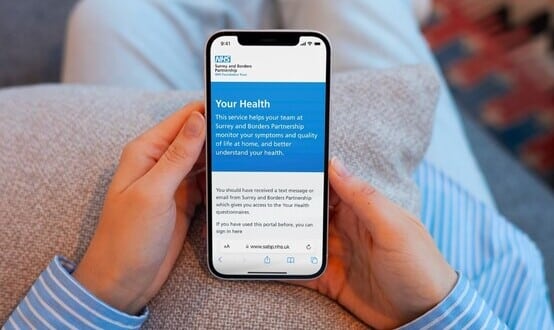NHS Long Term Plan: Reaction from healthcare IT leaders
- 8 January 2019

A number of leading figures and companies in the health IT sector have been giving their thoughts on the NHS Long Term Plan.
Published on 7 January, the plan includes a chapter solely on digital technology which details aims for the coming years.
It states that, in 10 years’ time, the “NHS [in England] will offer a ‘digital first’ option for most, allowing for longer and richer face-to-face consultations with clinicians where patients want or need it”.
Following the publication of the document, a number of leading figures and digital companies posted their response.
This included Sarah Wilkinson, chief executive at NHS Digital, who said the plan offers a ‘hugely exciting vision’ for the health service.
She added: “A key focus of the technology and digital agenda, as with the plan overall, is allowing patients to better manage their own health and care. A broad spectrum of digital services will support individuals to take a much more proactive and responsible approach to monitoring their own health and well-being, enabling them to recognise their individual health risks and symptoms as early as possible, and manage their personal response to these risks. This, in turn, reduces the demand for health and care services.
“We know how challenging it can be for organisations, particularly those under constant pressure to deliver critical services, to adopt new technology and digital systems.
“We are completely committed to supporting NHS organisations on all aspects of this journey from technical education, to integrating new technology into services and care pathways to the design of highly usable and accessible patient-facing solutions.”
This sentiement was endorsed by national CCIO, Simon Eccles, who tweeted to say: “Good digital services are essential to improving the NHS”.
Babylon Health, the brains behind the NHS’s GP at Hand service, tweeted to say it was “committed” to helping the NHS achieve the plan.
Babylon Health is committed to helping the #NHS achieve its #LongTermPlan by building a new digital health model with @GPatHand. We are bringing clinical and tech teams together to help reshape the way the NHS can provide care #healthtech #digitalhealth #NHSlongtermplan
— eMed UK (@uk_emed) January 7, 2019
A number of suppliers also gave their opinion on the Long Term Plan with David Hancock, client engagement director at InterSystems, welcoming it.
He added: “We expect to see the ambitions in the plan turned into positive action by the forthcoming local plans and we know that technology will be important in realising the commitments to improve patient care. We are committed to working with, and supporting, the NHS and other software suppliers in delivering the vision.”
In addition, Alan Fowles, international president at Allscripts, said the plan showed “exciting possibilities”.
He said: “It is encouraging to see that the long term plan recognises that the NHS needs a new service model for the 21st century, and that this model needs to make full use of digital technology.
“Allscripts is already working with health and care communities that want to use shared records to join-up and co-ordinate their services, and to reap the benefits of population health management.”
Despite a number of people praising the plan, some questioned whether it could all be done in the timeframes given.
Richard Murray, chief executive at The King’s Fund, said: “This is an ambitious plan that includes a number of commitments which – if delivered – will improve the lives of many people.”
He added: “While NHS leaders have done what was asked of them within the constraints of the funding settlement provided by the government, some significant pieces of the jigsaw are still missing. A number of decisions – notably on hospital waiting times – have been postponed, indicating that trade-offs and difficult choices lie ahead.”





9 Comments
There’s a lot of good stuff in the plan but also many questions. I’m not clear on the nature of LHCRs and PHRs. I’d love to see some pictorial representations.
I also welcome the return of more clinical expertise to the NHS 111 service given that it’s been shown to be a reason for increased A&E attendances compared with its predecessor, NHS Direct.
Some great and exciting challenges backed by some very good people at the centre. We just need to ensure open and honest conversations with all stakeholders.
The plan exist in a vacuum until we get the Green Paper on Social Care (assuming it actually addresses the issues) and a credible workforce plan
Or what Prof Trisha Greenhalgh has to say
https://pbs.twimg.com/media/DwZ7BgjW0AEKEZv.jpg:large
Have you looked at @DrMurphy11 ‘s tweets on his experience with Babylon Health’s Chatbot?
I’m not clear whether “Digital First” consultations are intended to replace traditional face-to-face and telephone consultations with AI Triage or just mean increased use of telephone, Skype (or equivalent: has anyone involved read the Skype/Microsoft Privacy & Cookies policies?) , nor is it clear whether the intention is to replace face-to-face consultations with a Digital Only service in some (or all) Digital First practices.
I see full digital medical records for secondary care – first demanded in 2002 – has been postponed yet again.. and I may have missed any requirement for secondary care records to be interoperable.. however that might be defined.
Could we get a few more reactions?
Exactly, it’s a gimmick. Clearly technology can play a significant role in service improvement but this appears to be simple cost cutting where the patient will suffer. Shame on those who support Hancock on this.
“technology… appears to be simple cost-cutting, where the patient will suffer. Shame onthose who support Hancock on this.”
Sorry, mate, the patient also suffers from a LACK of technology, which is emphatically not just about cost-cutting.
Two immediate personal examples:
–
1. My wife has been going spare because she has been waiting for a consultant’s report on an appointment done in mid-December. It finally arrived as a snail-mail yesterday. A month lost in dealing with her condition.
2. A snail-mail appointment letter from a local hospital to me under the “two week rule” was lost in the Christmas mail. So I was accused of missing the appointment. I don’t claim that the this delay has messed up my life-chances, but in more extreme circumstances it could have done.
The moral is that the judicious use of technology , in the form of email – something used by every industry except healthcare for decades – should be at the heart of patient care. Shame on anyone who is so luddite to think otherwise.
Yes, indeed, it would be nice to have more reactions from secondary care, particularly clinicians.
Also, Mary, Your GP contributions (and Neil Paul’s) are very important, and I would like to hear more GP voices. I am always grumbling that the health care sector live in little boxes. And it doesn’t help if the inhabitants of the boxes spend their time talking to themselves, and not to the inmates of neighbouring boxes..
The question of letters by ‘snail mail’ from hospitals suggests – to me – more a problem with *organisation* than with technology (although technology could be implicated).
Working backwards from the patient: –
1. It is reasonable for the hospital to assume that *all* patients have a postal address, and that the postal service is reliable: how reasonable would it be to assume that patients have the means to receive electronic communications, or that these are up to date?
What mechanisms could/should hospitals (& other Trusts) implement to ensure that email addresses are both secure and still current? Would any procedures be both foolproof & cost effective?
2. The communications from the hospital have to be prepared. In the case of the letter from an out-patient appointment, this means that whoever saw the patient has to gather any additional information (I assume in your wife’s case there was some – or all the information could have been conveyed at the appointment), dictate the letter, get it typed (quite possibly by a typing pool, in order of receipt), check & sign it (assuming this is a necessary step, & the individual concerned was not a locum, is not on leave, & has not changed posts), then the mail room has to put it in an envelope with the address & convey it to a post office. The appointments, I agree, often seem to be sent out so shortly before the date that it might seem a dastardly plot to cause maximum inconvenience to the patient – & a real risk of producing DNAs..
I’m open to conviction that IT could help – just not sure how you would plan to implement it, -especially after the recent 3 day outrage in NHSMail!
Indeed, Mary, the NHS’s organisation would have to be changed for email to replace snail-mail effectively. Not a bad thing, if the patient can learn quicker what is to happen to him/her, and to save the NHS a fortune on stamps and envelopes.
1. Can we assume that people change their email addresses more often than their postal addresses? The scandal that happened last year of hundreds of thousands of NHS letters going astray, and ending up being dumped in a shed by the semi-NHS body that was supposed to redirect the documents, indicates that postal addresses change rapidly – and that NHS staff are rather sloppy in addressing the letters in the first place! My first reaction to this cock-up was that it could never have happened if the documents were digital.
Of course, the 20% of patients – the old and poor – who do not have internet connections will have to use the current manual system. Indeed, but 80% of patients will get a more prompt service.
2. Preparing the appointment email could be slicker than a snail-mail letter. “Other information” could be already online and more accessible . The text could be dictated straight to the screen, without recourse to typing pools, and of course, there are no envelopes to be stuffed. or stamps to be stuck on.
There are, of course, lots of security problems to be sorted, which I am not competent to do, but I am sure other Government departments could give lots of help.
Anyway, I stick to my long-held belief that doctor/patient email should have been sorted out by the turn of the century.
Comments are closed.